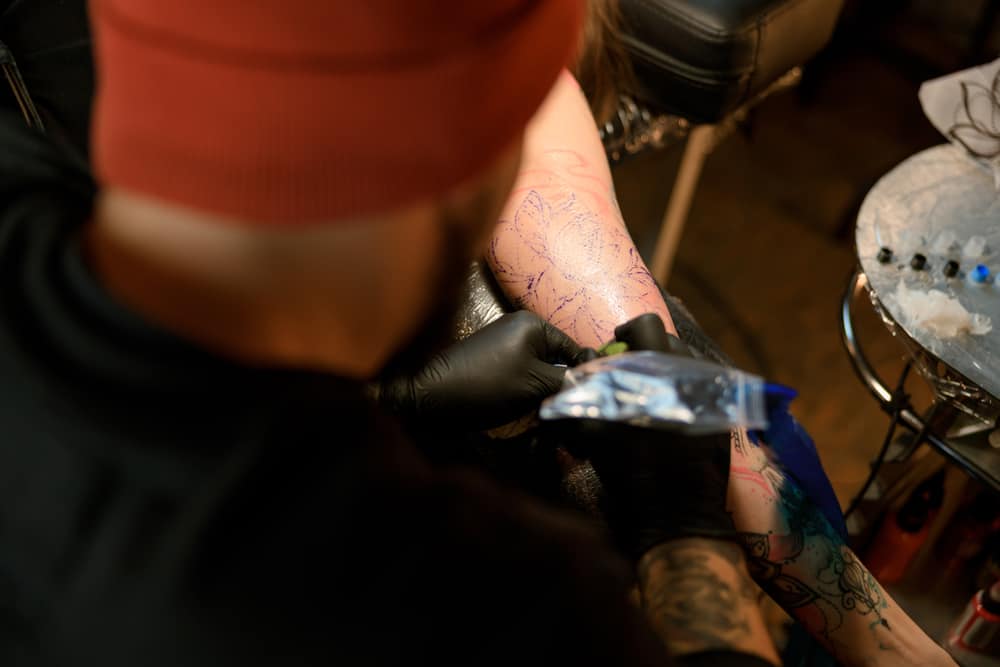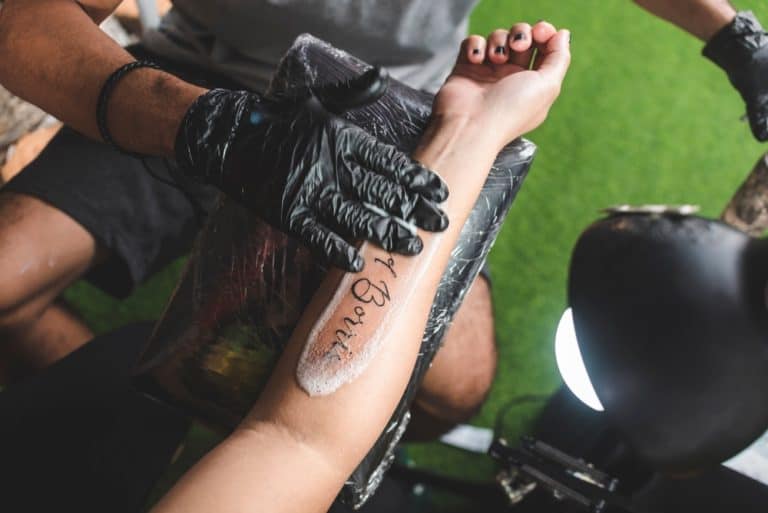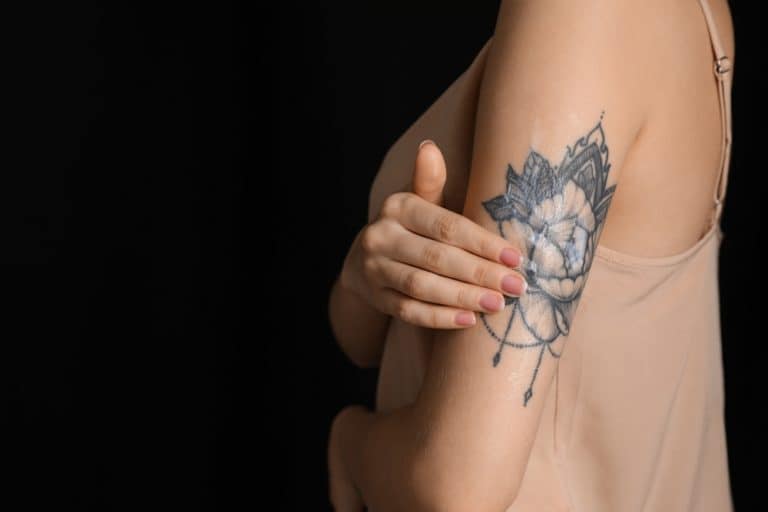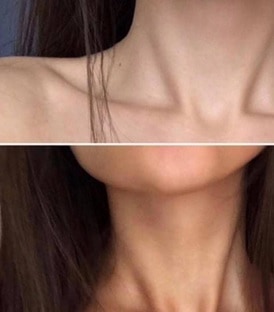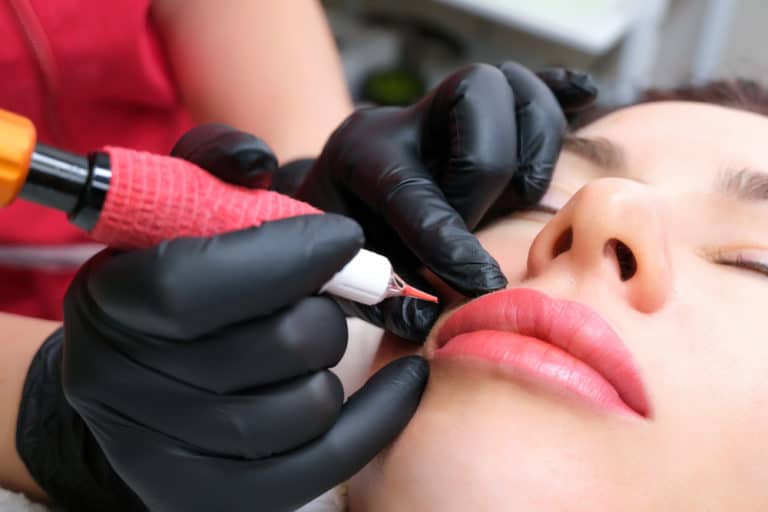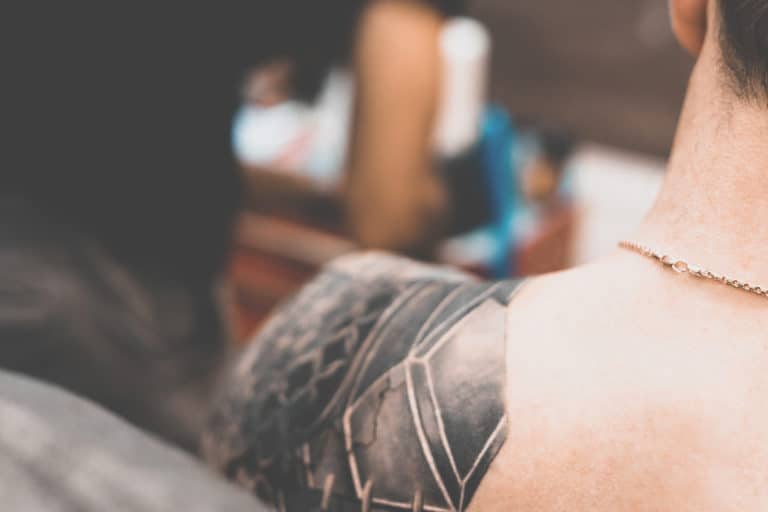What Happens If You Put Bleach On A Tattoo?
We all know getting sunburnt is a bad idea, especially if you have a tattoo. But what happens if bleach comes into contact with your ink? Even when you try to avoid bleach, it finds you. For example, there is chlorine in swimming pools. Then there is bleach in a lot of hair products and skin creams. Even if you try to use eco-cleaning products, sometimes you need bleach.
Bleach, such as chlorine, should be kept away from fresh tattoos still healing. The irritation bleach can cause to the wound can lead to an infection in addition to the damage it can do to new ink. After a tattoo heals, minor encounters with bleach won’t hurt your ink.
Not everyone is trying to preserve their ink, we know. Our tastes change, mistakes are made, and sometimes we regret our previous life choices. But laser removal is incredibly costly, in addition to being more painful than getting the tattoo. Thus, sometimes people look at bleach as their answer. But this can have nasty side effects, and it probably won’t work.
Why You Need To Avoid Bleach While Your Tattoo Heals
When you get a new tattoo, you are being given an open wound. Like any open wound, it takes time to heal. But in addition to the fresh wound, you have ink that you want to preserve and keep in your body.
Bleach is a cleaning agent, so it logically sounds like it would help keep the wound clean, and getting some on your tattoo, such as from some dripping off your hair dye, wouldn’t be a big deal. But bleach, including chlorine, is also a massive skin irritant. This can hurt the skin further, leading to infection and making the body more determined to push out the ink.
So if you have a new tattoo, you need to avoid bleach. That means:
- No lightening creams
- No swimming pools or hot tubs, even if they are “salt only”
- Avoid getting cleaning products on your new ink
- Avoid hair dyes and lighteners if you have a tattoo from the shoulder blades up, such as the chest, collar bone, and neck
What To Do If I Get Bleach On A New Tattoo?
Mistakes happen. Maybe a co-worker was cleaning the work surfaces and accidentally sprayed your forearm tattoo with the pandemic-strength bleach. Or your hairdresser was convinced they’d covered you up safe and sound, but somehow that bleach found a way down your collar and into your newly tattooed cleavage.
What is done is done, but you can limit the damage and hopefully avoid most, if not all, negative consequences.
The first step is to get the bleach off. This means rinsing it, but carefully, cupping water, and letting it run over the tattoo.
- Do not use a powerful spray shower to rinse it off
- Do not soak the tattoo
- Do not scrub the tattoo with your hand, lofa, or anything else
If there is a dye stain, that’s fine. You just need to get the chemicals off your skin. Trying to scrub off skin discoloration will cause more damage than leaving the stain, which will naturally go away with time.
The second step is to gently pat the area dry. Do this only after the area is thoroughly rinsed, and no bleach remains on your tattoo. Pat, do not rub.
Lastly, apply the ointment your tattoo artist advised you to use while it heals. Remember to spread it thinly. Adding too much ointment to a tattoo can harm the ink.
However, call the artist and ask their advice if you have any concerns. If you have any severe burning and pain, get proper medical help or advice immediately.
Needing To Get Into A Pool With A New Tattoo?
You should not ever soak a new tattoo. Never go into a hot tub or a pool with a new tattoo, even if it isn’t chlorinated. You shouldn’t even exercise with a fresh tattoo, let alone swim laps. This is why summer isn’t a great time to get new ink because you’ll have to avoid pools and the ocean for four weeks.
Chlorine or salt from the sea can cause a rash to damaged skin, leading to infections or dermatitis. Nor does chlorine kill all bacteria in the pool, so you are almost guaranteed infection. Exposure to chlorine or seawater will also slow down the healing process.
In addition, chlorine and salt water can cause the ink to be leached from the skin. Even if by some miracle you avoid infection, the tattoo can fade, become patchy and even turn blurry.
However, sometimes crucial physiotherapy has to be done, and you find yourself being told you need to get into a pool despite just having obtained brand new ink.
Firstly, this situation is rubbish, and we feel very sorry for you.
Secondly, you should call the artist and as for their advice.
However, if the artist is not available to advise, then you can try the following:
- Apply a waterproof dressing, such as Saniderm, just before you get wet
- Make sure the dressing completely covers the tattoo
- Make sure the dressing is on for as little time as possible
- Once you are done with your physio session, remove the dressing as soon as possible
- Pat dry
- Rinse as directed by your tattoo artist
- Pat dry
- Apply a small amount of the cream given to you by your artist
Only do this if you absolutely must. It is not a perfect solution. Covering a tattoo, aside from the initial covering the artist applies, is not good for the tattoo. Leaving a tattoo-covered can ruin a tattoo and invite infection. This is only for an emergency situation and should be done for as small a time span as possible.
What To Do If I Already Got Into A Pool With A New Tattoo?
Sometimes we make poor choices, such as jumping into a pool or hot tub with a new tattoo. Or maybe your waterproof dressing didn’t hold. Things happen.
Firstly, beating yourself up won’t help, so stop. There is no time machine to help you fix the past, so just focus on the future.
Secondly, while guilt and stress won’t fix the problem, you can deal with it responsibly and keep an eye out for any issues.
Thirdly, your tattoo artist can’t fix any fading, blurred lines, or touch up any areas until after the tattoo has completely healed. However, tattoo artists have seen it all, so staying in communication can still help. They might have advice for any issues that crop up, such as bubbling, or tell you when you need to seek medical assistance.
Sending them a photo or, if allowed, dropping in to show them any troubling spots in person are never a bad idea.
However, if any of the following happen, see a medical professional right away:
- Skin feels hot, especially to the touch
- Redness gets worse or begins to radiate from the design
- Worsening pain or severe discomfort
- Blistering, rashes, or open sores
- Fever
- Chills
- Bleeding from the tattoo
- Pus or stinky discharge emitted from the tattoo
Treat the medical problem first. Then, you can consult the tattoo artist about cosmetic fixes to the tattoo after you and your ink are fully healed.
Will Bleach Or Chlorine Hurt A Healed Tattoo?
You can swim or get your hair lightened after a tattoo has fully healed. A healed tattoo is no longer an open wound. Thus, infection can’t get into your tattoo, and the ink cannot be pushed out.
Tattoo ink sits 1.5-2 millimeters underneath the surface of the skin. Thus, the ink sits below the outer layers, the epidermis, which is responsible for our skin tone and waterproofing qualities. This is why a healed tattoo never looks as bright and vibrant as a freshly inked tattoo. This is because a healed tattoo has the ink showing through the deeper layer, not on the surface.
The dermis, where your tattoo ink sits, is where you have your connective tissue, sweat glands, and hair follicles. This is above your hypodermis, which has fat and more connective tissue. Thus, the ink is sandwiched between two separate layers, preventing it from being absorbed by the body and being sloughed off by everyday actions, such as swimming.
Bleach and chlorine do not emit UV light. Thus, these chemicals cannot penetrate the dermis and hurt the ink once the tattoo is healed. However, UV light from the sun can break up the ink and allow the body’s immune system to begin absorbing it, hence why sunlight fades tattoos. Lasers are an even more intense process of breaking up the ink.
But again, once the tattoo is healed, the power of bleach or chlorine will not harm your tattoo. It is advised to keep any bleaching agents, such as hair products, off your tattoo as much as possible. But that’s partly because the skin can be more sensitive after it’s been tattooed. You can swim, bleach your hair, or have it colored once your tattoo is healed.
Using Bleach To Remove A Tattoo
Getting a tattoo lasered is a costly and painful experience. It also requires more than one session. Thus, some people turn to home remedies to try and remove the tattoo by themselves.
Please don’t do this.
Bleach won’t lighten a healed tattoo. It can, however, damage your skin. Also, home remedy advice often encourages harsh exfoliation and opening of the skin to try to get the “remedy” deeper into the skin. This not only hurts but can permanently harm the skin or invite infection.
As we mentioned earlier, healed tattoos have ink in the dermis, not the epidermis. Thus, bleach and other skin lightening creams that often contain bleach variants are not acting on the ink. Instead, it is lightening the melanin in your skin.
Thus, any initial “progress” lightening creams produce results from the melanin being broken down. As a result, the tattoo might look lighter because the skin covering the ink is lighter.
Sometimes tattooed skin reacts to the needling by producing extra melanin. The lightening creams used during laser removal are trying to address this and the damage from the laser. However, these creams are specially formulated not to cause further harm to your epidermis. But a DIY bleach job might actually increase the melanin production in that area.
Hyperpigmentation can be caused by a reaction to using bleach or other lightning agents. The darker skin can last for months or be permanent. This is risked each time you try to aggressively remove your own tattoo.
Bleach can also burn the skin if left on too long or applied in strong concentration. These burns can cause permeant scaring, which not only can leave an altered texture to the skin but also cause hyperpigmentation.
Thus, applying concentrated bleach or other DIY tattoo removals can result in:
- Hyperpigmentation
- Other types of skin discoloration
- Scarring
- Infection
- Rashes, blisters, and other sores which can also become infected
- Burns, which can also leave scarring or become infected
Is Using Professional Tattoo Creams Safe?
Most professional lightening creams used by laser removal outlets won’t burn your skin like DIY methods. So in that sense, they are safe. However, not all tattoo artists and dermatologists are fans, even of the high-grade ones labeled as “tattoo removal creams.”
These creams are still just working on the outer layers of the skin. Maybe they’ll help with any increased pigmentation acquired from tattooing or even the laser. On the other hand, they might also cause hyperpigmentation, just as the DIY recipes do. Thus, these products are something to be cautious about.
For what it is worth, the only FDA removal method is laser removal. There are different types of lasers and various pros and cons to the various laser techniques and machines. Regardless, none of them have anything to do with bleach.
Conclusion
Bleach and chlorine are not suitable for a brand-new tattoo. Thus, it is best to avoid things like pools and hair bleach from getting near your new ink. However, after your tattoo is healed, bleach will not hurt your tattoo. However, bleach can damage your outer skin if you misuse it in an attempt to lighten your skin or your tattoo.
References
- https://tatring.com/fixing-hiding-tattoos/Attempting-to-remove-a-tattoo-at-home-Part-2
- https://www.healthline.com/health/body-modification/everything-you-need-to-know-about-swimming-with-fresh-ink#how-to-tell-if-its-healed
- https://removery.com/blog/tattoo-lightening/
- https://www.refinery29.com/en-us/swimming-after-new-tattoo
- https://www.healthline.com/health/skin-bleaching#diy
- https://www.medicalnewstoday.com/articles/318388
- https://www.webmd.com/skin-problems-and-treatments/picture-of-the-skin

